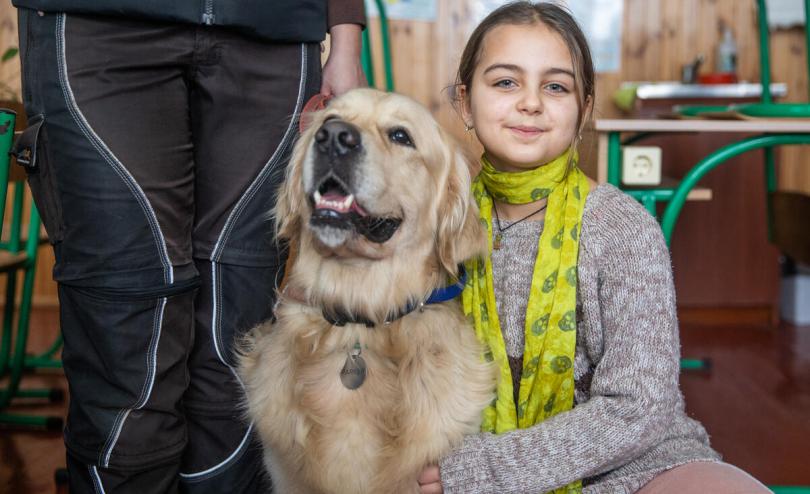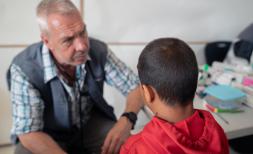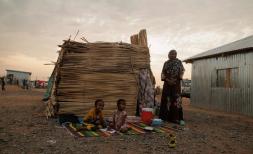Ukraine: Schools destroyed. Life in bunkers. Families divided. 6 ways the war has impacted children

Viktoriya*, 9, poses with golden retriever Parker, a two-year-old therapy dog, during a dog therapy session at a school outside of Kyiv, Ukraine (Oleksandr Khomenko/Save the Children)
KYIV, 22 February 2023 - The conflict in Ukraine has had a devastating impact on children over the past year, with nearly 1,500 killed or injured, while others have fled thousands of miles from home or been forced to seek safety in bunkers for days on end.
No experience is exactly the same.
Save the Children has identified six major ways the war has affected the 7.5 million children in Ukraine.
1. Child Casualties
A pile of teddy bears placed outside a destroyed apartment building in Dnipro symbolised the constant danger facing children in Ukraine. The building was blown apart by a missile in January, killing six children and injuring 126 people.
Grave danger faces children at every turn. According to the UN, as of 21 February 2023, 487 children in Ukraine have been killed since the conflict began along with 954 injuries.
 Mourners in Dnipro placed toys, flowers, and candles at a bus stop near the apartment block that was destroyed by the missile strike (Vladyslav Garnaiev/Save the Children)
Mourners in Dnipro placed toys, flowers, and candles at a bus stop near the apartment block that was destroyed by the missile strike (Vladyslav Garnaiev/Save the Children)
2. Mental health impacts
The constant threat of missile and artillery strikes as well as daily sirens is having a profound effect on the well-being of children in Ukraine, and psychosocial support is essential to help prevent long-term trauma.
That’s why Save the Children has set up ‘child friendly spaces’ across Ukraine. A small beacon of peace, where children can play, socialise, relieve stress and feel like children again.
Save the Children also trains staff to conduct therapy sessions with pets. Parker the golden retriever (see photo) was an instant hit with children in communities near Kyiv.
 Viktoriya*, 9, poses with golden retriever Parker, a two-year-old therapy dog, during a dog therapy session at a school outside of Kyiv, Ukraine (Oleksandr Khomenko/Save the Children)
Viktoriya*, 9, poses with golden retriever Parker, a two-year-old therapy dog, during a dog therapy session at a school outside of Kyiv, Ukraine (Oleksandr Khomenko/Save the Children)
3. Forced underground
Persistent air strikes and explosions are forcing millions of children underground. In fact, Save the Children calculates that the average child spent about 900 hours underground – about 40 days - in bunkers and other subterranean spaces last year.
To help children in bunkers maintain some sense of normalcy, Save the Children has distributed psychosocial bunker kits to families across Ukraine.
They contain toys, games, arts and crafts to promote learning. They also have mental health activities to help children manage stress underground while shelling continues overhead.

‘Psychosocial kits’ for children to play with when they are sheltering underground from missiles in Ukraine (Save the Children)
4. Schools and hospitals under fire
On average, four schools have been destroyed or damaged every day in the past year, according to data published by the Ukraine Ministry of Education and Science, and there have been 764 attacks on health care facilities since conflict escalated as of February 6 2023.
 A hospital in Kherson, Ukraine, which has had much of its equipment looted (Save the Children)
A hospital in Kherson, Ukraine, which has had much of its equipment looted (Save the Children)
Schools close to the areas of active fighting did not reopen on 1 September. Remote learning and hospital care are further disrupted by frequent power cuts.
Across Ukraine, Save the Children is establishing Digital Learning Centres and distributing Education Kits with stationery, so children can continue with their studies both online and in-person.
We also provide medical equipment and supplies to hospitals and mobile health teams, with a particular focus on maternal and newborn health.
5. Families separated
The onslaught of war means millions of children have had to flee, saying goodbye to loved ones and leaving their usual lives behind.
Over six million people within Ukraine are currently displaced, while almost eight million refugees have fled to Europe.
Far from home and separated from friends and family, refugees are struggling with their mental health. A survey by Save the Children found that 44% of refugee children in Europe are feeling lonely, while 55% are worried about their future.
6. Poverty
Fuelled by war and rising inflation, poverty across eastern Europe and Central Asia soared by 19% this year, according to UNICEF, while the conflict has dragged an additional half a million children in Ukraine beneath the poverty line.
Hardship for children in Ukraine has worsened due to dwindling harvests - 40% of land assigned to wheat cultivation has been destroyed, causing economic problems at home, while endangering the lives of millions of children in Africa who rely on the grain for survival.
...
Over the past year, over 18,000 civilians have been injured or killed in Ukraine. Despite this grim picture, families are pulling together and showing tremendous resilience.
In the year to come, Save the Children will continue to work tirelessly to lessen the impact of war on children. We’ll keep delivering vital necessities. We’ll also carry on demanding that civilian objects - including schools, hospitals and homes – do not become battlegrounds.
---ENDS---
Note to Editors:
- *Viktoriya’s name has been changed to protect her identity
************************************************************************************************************
For further enquiries and interview requests please contact:
- Vsevolod Prokofiev, Media Manager, Ukraine (based in Kyiv): vsevolod.prokofiev@savethechildren.org
- Nina Teggarty, Global Media Manager, Ukraine (based in London): nina.teggarty@savethechildren.org
Our media out-of-hours (BST) contact is media@savethechildren.org.uk / +44(0)7831 650409
Please also check our Twitter account @Save_GlobalNews for news alerts, quotes, statements and location Vlogs.




